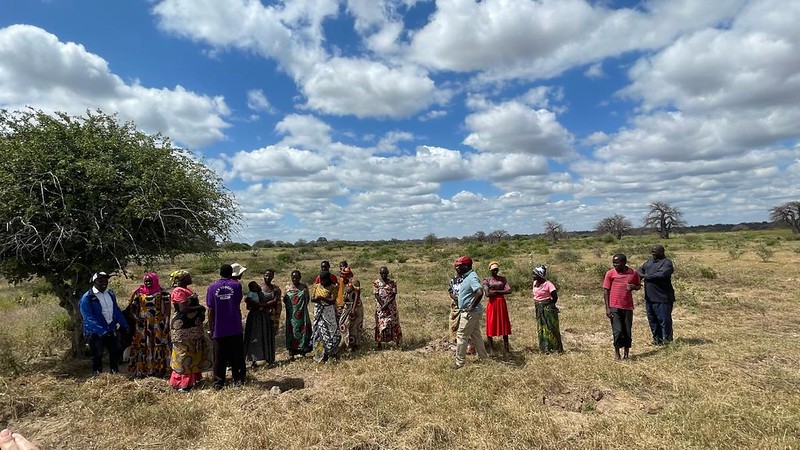Dodoma, United Republic of Tanzania (May 13-17, 2024) — Climate change impacts on local agriculture were evident during a five-day country exchange convened in Tanzania by the Adaptation Fund (AF) and its national implementing entity (NIE) partner there, the National Environment Management Council (NEMC).
NEMC is implementing several AF-funded projects that are empowering vulnerable communities to adapt and build resilience to temperature rise and drought in innovative ways. Focused on sharing knowledge, best practices and lessons learned from AF-funded projects, the country exchange brought together nearly 30 NIEs from across the globe and another 15 NEMC and AF staff to discuss the theme of locally led adaptation. A few days of discussions were supported by two days of project visits.
The group travelled a few hours by bus outside the capital of Dodoma over cratered dusty roads, past expansive landscapes and scattered livestock herders to reach AF-funded project sites in the Kongwa and Bahi districts. In these impoverished rural areas, the sun bore down fiercely on newly planted trees as farmers worked hard to irrigate them and keep pace with the drying climate.
The US$1.2 million Kongwa project is aimed at enhancing climate-resilient water supply systems in agropastoral communities, transforming unsustainable land practices into diversified climate-smart livelihoods, improving ecosystems and adaptation capacity, while the US$ 1.3 million Bahi project is restoring natural dams to harvest water, developing inclusive afforestation programs for locally adapted fruit and forest trees, improving agricultural technology, and enhancing community adaptation learning.
Both projects are providing water closer to villagers while improving human, environmental and animal health. “Most of our projects are directed to the semi-arid areas, and most of the people did not have access to water, especially the villagers in Kongwa and Bahi districts who were used to traveling long distances, up to 5 km, to fetch water that is carried [by women] on their heads, so it’s quite hard,” said Fredrick Mulinda, NEMC’s Project Coordinator. “The project has helped villagers access water for domestic use, but also for animal use. Most of the poor villagers have had their livelihoods improved because through the projects they are cultivating how to care for and grow crops and they are selling some so they are getting some income. The district officers have participated in the process, so we believe their capacities in integrating climate change adaptation in their daily activities has also been enhanced.”
The gains are myriad, and the projects are attracting public interest. “It has helped a lot in solving the conflicts between livestock keepers and farmers,” said Mulinda. “They were competing over the meager resources of water. Now most of the conflicts have been settled. They want to upscale them in other areas because we have a very big area that is experiencing the same [climate] impacts.”
At Ibwaga Secondary School in Kongwa, students demonstrated how the project is empowering them to learn sustainable gardening as they grow diversified vegetables like spinach, figs, collard greens and maize in a large garden at the school. They are learning water-conserving drip and bag irrigation techniques while generating income for the school and sharing knowledge with surrounding villages. School families are seeing a reduction in grocery spending by about 60,000 TZ a month.
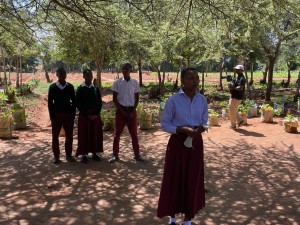
School Garden at Ibwaga Secondary School in Kongwa
“These green vegetables from our garden projects have many benefits in different sectors to us and the school societies around us,” said student leader Yaeli Protus Mushi. “This project started in 2022 and has continued to grow. We get different skills from this garden such as knowledge about sowing the seeds, how to care for them during seedling stage and how to make them grow to mature stage. We can apply these skills at our homes, and we are benefiting from acquiring vitamins that are provided by the vegetables. We reduce the cost of buying vegetables outside of our school. Before this project started, we had to walk farther and farther away to get green vegetables to mix with our meals. Now we are enabled to easily get the green vegetables, and the money is budgeted in other programs.”
Eva Alphonse, Head Mistress of the school, expressed gratitude for the project. “We have benefited very much from this,” she said. “Before we used to buy these vegetables and you cannot buy them in a large quantity. Now at any time we can take it and have it for our meals. It’s great to see how the students enjoy cultivating these vegetables.”
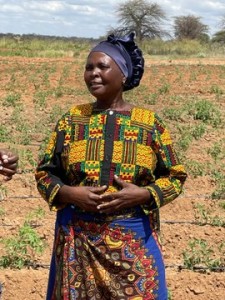
A beneficiary managing one of the block farms
In another area of the project, seven villages are benefiting from a self-contained 50-acre ‘block farm’. Divided into blocks, each features a different crop like drought-resistant tomatoes, onions, carrots or plantains. Groups of 15-30 villagers take turns learning and cultivating each block and benefiting from sales of crops they produce, while spreading knowledge to others. About 200 families work on the site at a time, with about 5,000 households benefiting. The groups are well-represented by men, women and youth, and learn skills such as climate-smart farming and managing finance.
“The communities come in groups from different villages to learn,” said Dr. Dominic Kilemo, who helps supervise Chimotolo block farm. “Every two years we have new groups come in. For sustainability some of the money from these sales is paid here to maintain the running costs to maintain the facility.”
Jaba Sungo grows bananas that don’t require much water. “We want people to learn how to grow bananas and spread the knowledge,” he said.
Athanas Njemethi manages a block with hybrid bulls adapted to arid areas that produce higher quality and quantity of milk and meat than typical bulls. “People are ready to pay more (for calves),” he said. “I hope to build a modern house for my family and have our own bore hole.”
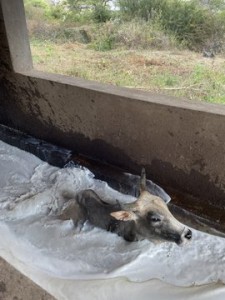
Cattle Dip – A Medicinal Bathhouse built for livestock
Meanwhile, a new medicinal bathhouse built in Kongwa has brought preventive healthcare to a central location serving 7,000 cattle and goats. In the past herders had to travel up to 25 km for the service, which provides a medicated dip for livestock to bathe in. The cost per animal has been cut in half. It is supervised by a committee of local leaders from seven surrounding villages, including two women, and they’ve seen a reduction in livestock illness from 15-20% to 5%. “We are so thankful,” said cattle dipper Ernest Mhulula. “We used to travel very far. We are aware of how to care for the cattle and have healthy cattle now. This has helped a great deal to reduce the tick-borne and skin diseases that destroy the health of the cattle. We see reduced deaths.”
A similar dip house was restored in Bahi district. Paul Kusolwa, who helps supervise it, said it serves as a central spot for eight villages and cleanses about 4,000 animals every two weeks. “It was a big problem before because of tick-borne disease. It’s already impactful for them. If healthy, the herders can easily sell them [and at better prices],” he said.
Several components to the Bahi project are inter-connected, including an afforestation initiative to establish fruit and forest trees, as well as bee keeping and vegetable gardening. Water is fed throughout the site to strategically located troughs and tanks by solar-powered water pumps and lines from a nearby water reservoir. “Being very dry here, especially for drinking water for animals, the drinking trough is really solving the climate problem,” Kusolwa said. “They used to drink in the river, but in the fall no water was left. This (reservoir) will be a continuous water source. They are comfortable now, and livestock farmers can stay here now. It’s providing a sustainable livelihood for 6,000 people. They sell livestock in the market auction every week. You get healthier animals. This avoids migration of the farmers.”
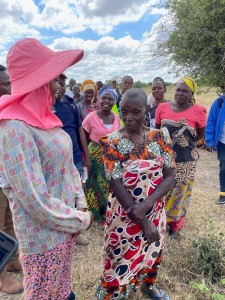
Local women’s group managing tree nurseries
Farmers are sustainably growing trees, with 30,000 seedlings distributed to communities in the area. A local women’s group received training in managing tree nurseries, watering them and removing weeds. They are taking charge of tree planting and care in a large open field where the sun pelts down for long stretches of the day. They hope to convert it into a thriving area of shade gardens, with orange, mango and avocado trees. It used to take them three hours to retrieve water on their heads, but now water is pumped to the nearby tanks. “It’s difficult to establish, but we’re striving,” Kusolwa said. “The weather is very harsh. The planted trees need irrigation every two days. We’re trying to recover forest here. In the past it was used for sorghum grain and farmers pulverized the soil. The dam became completely silted. By preventing cultivation here, we are protecting the dam. Hopefully the trees come.”
Farmers decided on the types of plants that would grow well in the local climate. So far, at the Bahi site a 3-acre block of fruit trees have had an 80% survival rate. They were planted two meters apart to allow room for growth up to 30 meters. “This will prevent runoff and protect the dam,” said Kusolwa. “The big aim with the trees is to create a micro-climate, so it could attract more clouds and rain. It will help with carbon sequestration and fostering a cooler climate, and people can pick orange and mango fruits. This place is expected to be very wonderful. We also distributed trees to farmers to plant in their households for shade, and some to schools, churches and offices.”
Restoring the nearby community-owned Mkwese dam was pivotal to establish the site’s water supply. Project participants cleaned it out from just two feet deep into a healthy natural reservoir that is now about four meters deep, 300 meters long and 35 meters wide. During the rainy season, the water reaches nearby baobab trees sitting on a hill over the dam. A combination of rainwater and well-placed deep bore wells has filled the reservoir. Orchards are being planted in surrounding areas, and even some fish farming has taken place at the reservoir.
“There has been a significant improvement in benefits since prior to the project,” said Steven Chitondole, who grows tomatoes and sells them to neighboring villages. He credited the solar pumps to improving the water supply while protecting the environment. “We can irrigate without using fuel-operated pumps.”
The project further has a strong focus on fostering opportunities for women and creating alternative livelihoods, including bee and honey cultivation (50% managed by women) with 150 hives planted in a large baobab tree on the site.
NIEs gained firsthand knowledge from seeing the projects in person. Md. Mahmuduzzaman, Deputy Manager of PKSF in Bangladesh, appreciated an innovative aspect where villagers wrap two tree plants (red ginger and mango) in one before planting to improve nutrient growth and climate resilience. “Both the projects were innovative in their own way,” added Ong Pulam Mouglang, deputy general manager of NABARD in India. “That was my first time seeing a block of land to grow produce in turns. It was diversified and self-sustaining. In the school project, I like the way they involve the students and the whole school and community. Most of those kinds of projects are needed, and they are replicable.”
Related photos and album | Watch video



